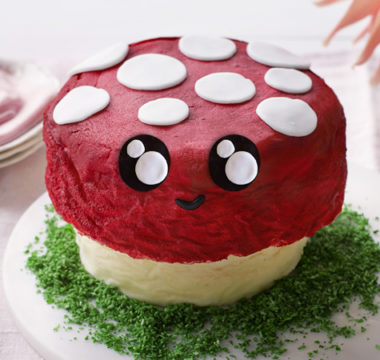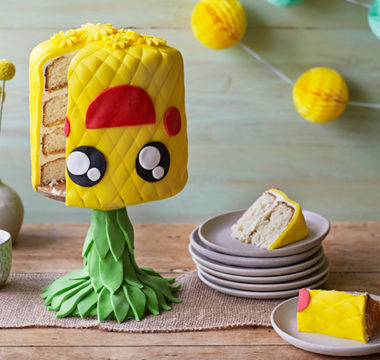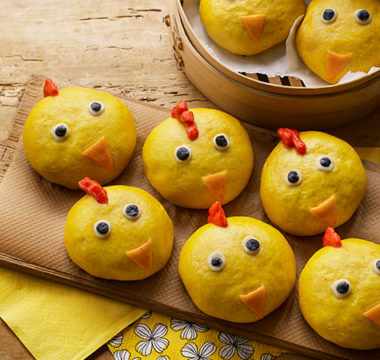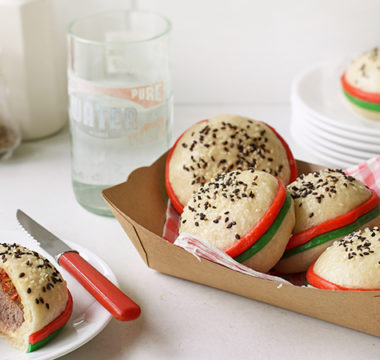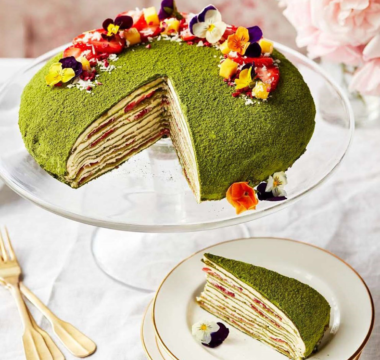Marc’s cake is a true showstopper for dog-lovers out there. Layers of ginger- and honey-flavoured cakes are wrapped in homemade fondant icing and decorated like human’s best friend. Note that this fondant uses gelatine leaves so is not suitable for vegetarians. Keep the egg whites in separate bowls when you separate the eggs for the sponges – you’ll need them for the buttercream. Finally, the macarons make more than you’ll need, but it’s hard to make macarons in smaller quantities – enjoy the remainder just because!
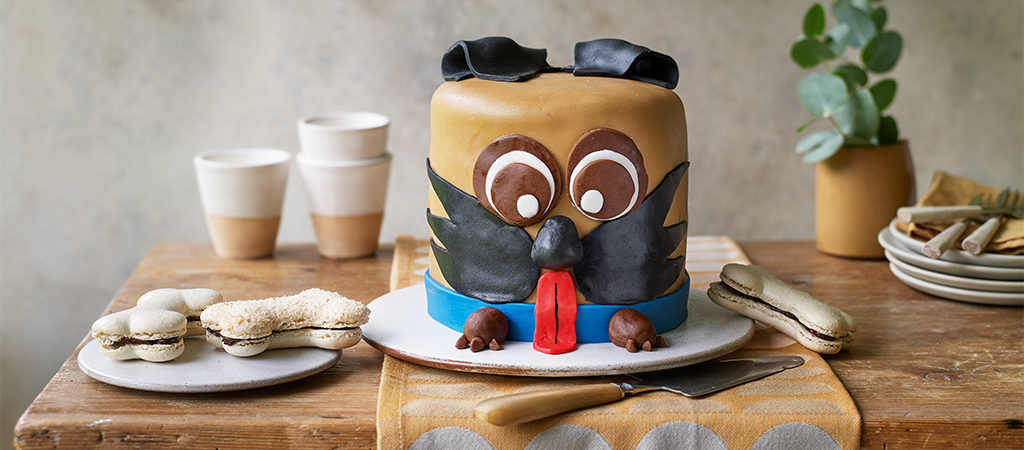

Marc
Series 11
- Ingredients
- Method
Method
Step 1
Heat the oven to 180°C/160°C fan/350°F/Gas 4.
Step 2
Start by making the ginger and kinako cake. Place the egg yolks in a large mixing bowl and add the butter, oil, buttermilk and brown food colouring. Using a balloon whisk, whisk to combine. Add 110g of the caster sugar and whisk again to combine.
Step 3
Using handheld beaters, whisk the egg whites with the cream of tartar until the mixture holds soft peaks. Gradually add the remaining 20g of caster sugar and continue to whisk until the meringue holds stiff peaks.
Step 4
Sift the flour, baking powder, bicarbonate of soda, ginger, kinako powder and pinch of salt into the egg yolk and butter mixture and whisk until smooth. Using a large metal spoon fold in one third of the meringue mixture to lighten the batter.
Step 5
Carefully fold in the remaining meringue until combined, then divide the batter between the prepared cake tins (about 250g per tin) and bake for 22–25 minutes, until well risen and springy and a skewer inserted into the centres comes out clean. Leave to cool in the tins for 3 minutes, then carefully turn out onto a wire rack to cool completely. Wash and reline the tins. Leave the oven on.
Step 6
To make the honey tahini cake, place the egg yolks in a large mixing bowl with the butter, oil, buttermilk, honey, tahini and orange food colouring and, using a balloon whisk, whisk until smooth. Add 90g of the caster sugar and mix again.
Step 7
Using handheld beaters, whisk the egg whites with the cream of tartar until the mixture holds soft peaks. Gradually add the remaining 20g of caster sugar and continue to whisk until the meringue holds stiff peaks.
Step 8
Sift the flour, baking powder, bicarbonate of soda and pinch of salt into the egg yolk and butter mixture and whisk to thoroughly combine. Add one third of the meringue mixture and mix in to lighten the batter.
Step 9
Using a large metal spoon, fold the remaining meringue into the cake mixture until combined. Divide the mixture equally between the lined cake tins and bake for 22–25 minutes, until well risen, springy and a skewer inserted into the centres comes out clean. Leave to cool in the tins for 3 minutes, then carefully turn out onto a wire rack to cool completely.
Step 10
To make the Swiss meringue buttercream, put the egg whites, sugar and salt into a heatproof bowl set over a pan of simmering water. Whisk until the sugar has completely dissolved and the mixture is foamy.
Step 11
Continue to cook for 3–4 minutes, whisking continuously, until the mixture is hot to the touch, thickens, starts to increase in volume, turns bright white and holds a firm ribbon trail when you lift the whisk.
Step 12
Pour the mixture into the bowl of a stand mixer fitted with the whisk attachment and beat on a medium–high speed for about 6 minutes, until the mixture has doubled in volume and is thick, stiff, glossy and cold to the touch.
Step 13
Gradually add the softened butter, whisking continuously until smooth and glossy. Add the lemon juice and zest and mix again to combine. Add the orange food colouring, mix until combined, then spoon the buttercream into the piping bag and cover until needed.
Step 14
To make the macaron dog bones, use the cutter to draw the outline of bone shapes onto the sheet of baking paper lining the baking sheet, spacing them well apart.
Step 15
Sift the ground almonds and icing sugar together into a bowl and set aside. Place 1 egg white into a medium mixing bowl.
Step 16
Combine the caster sugar with 2 tablespoons of water in a small pan and place over a low heat to dissolve the sugar. Allow to boil until the syrup reaches 110°C/230°F on a sugar thermometer. At the same time, use electric beaters to whisk the egg whites on medium speed.
Step 17
Continue to heat the syrup until it reaches 116°C/241°F, then carefully pour it into the mixing bowl, whisking continuously at slow speed. Increase the speed and continue to mix until cooled to room temperature.
Step 18
Fold in the icing sugar and almond mixture until just incorporated. Add the remaining egg white and continue to fold until smooth and the mixture forms a figure of 8 ribbon from the spatula. Scoop the mixture into a piping bag fitted with a plain nozzle and pipe into the dog-bone shapes on the baking paper.
Step 19
Drop or sharply tap the baking sheet on your work surface to disperse any air bubbles, then sprinkle half of the macarons with desiccated coconut. Leave uncovered at room temperature for 30 minutes, until a skin has formed on top of the macarons.
Step 20
Meanwhile, heat the oven to 170°C/150°C fan/325°F/Gas 3.
Step 21
Bake the macarons for 6 minutes, then reduce the temperature to 150°C/130°C fan/300°F/Gas 2 and cook for a further 12 minutes, until crisp. Remove from the oven and leave to cool on the baking sheet.
Step 22
To make the fondant icing, soak the gelatine leaves in a bowl of cold water for 5 minutes, until soft. Drain the leaves and squeeze out the excess water, then return the floppy gelatine to the dry bowl. Add 3 tablespoons of water and the liquid glucose and glycerine and stir over a pan of simmering water until combined and the gelatine has melted (about 2 minutes).
Step 23
Place the icing sugar into the bowl of a stand mixer fitted with the beater attachment and, with the motor on a slow speed, pour in the glucose mixture. Mix on slow until smooth and combined.
Step 24
Turn the fondant out onto an icing-sugar-dusted work surface and knead until smooth and stiff, adding more icing sugar if the fondant becomes sticky. Divide the icing in half and tint one half brown. Cover this portion with cling film.
Step 25
Divide the remaining fondant into quarters – tint one quarter blue, one black and one dark brown. Cut the remaining quarter in half and tint one half red and leave the remainder white. Cover with cling film until needed.
Step 26
To assemble the cake, place one of the ginger cakes on a cake board and cover the top with an even layer of buttercream. Top with a honey tahini cake and more buttercream. Top with the second ginger cake, another layer of buttercream and finish with a honey cake. Cover the top and sides of the cake with a buttercream crumb coat and chill for at least 15 minutes.
Step 27
Roll out the large piece of brown fondant on a lightly icing-sugar dusted work surface until 3–4mm thick and big enough to cover the whole cake (about 50cm diameter). Carefully lift up the icing with the help of a rolling pin and cover the cake. Use an icing smoother to smooth the sides and make the corners crisp and neat.
Step 28
Use the remaining fondant to make the features of the dog using the picture and paper templates as a guide. Stick these in place using edible glue. Use dark brown and white for the eyes, blue for the collar, black for the ears and whiskers/beard and red for the tongue.
Step 29
Prepare the ganache filling for the macarons. Heat the cream and golden syrup in a small pan until just boiling. Pour into a heatproof bowl with the chopped chocolate and butter and stir until almost melted. Cool until thick enough to spread.
Step 30
Spread the cold ganache onto the flat (underside) of half of the macaron bones. Sandwich with the other bones and arrange around the dog to serve.

